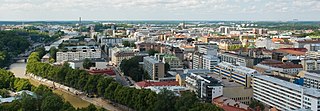
Turku is a city in Finland and the regional capital of Southwest Finland. It is located on the southwestern coast of the country at the mouth of the River Aura. The population of Turku is approximately 202,000, while the metropolitan area has a population of approximately 311,000. It is the 6th most populous municipality in Finland, and the third most populous urban area in the country after Helsinki and Tampere.
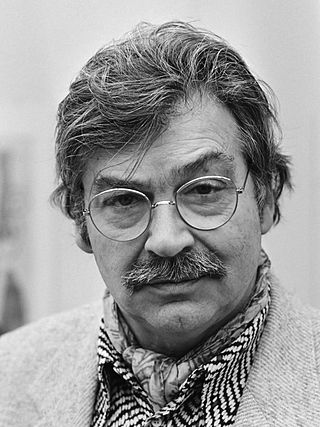
Christiaan Karel Appel was a Dutch painter, sculptor, and poet. He started painting at the age of fourteen and studied at the Rijksakademie in Amsterdam in the 1940s. He was one of the founders of the avant-garde movement CoBrA in 1948. He was also an avid sculptor and has had works featured in MoMA and other museums worldwide.
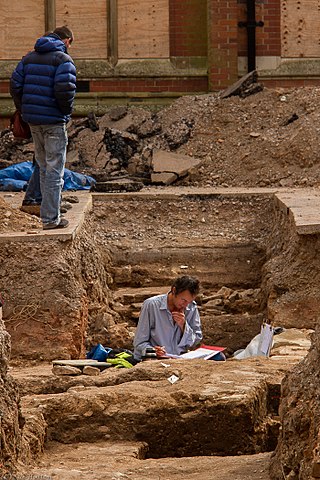
Urban archaeology is a sub discipline of archaeology specializing in the material past of towns and cities where long-term human habitation has often left a rich record of the past. In modern times, when someone talks about living in a city, they are in an area with many surrounding people and buildings, generally quite tall ones. In archaeological terms, cities give great information because of the infrastructure they have and amounts of people that were around one another. Through the years there has been one big method used for urban archaeology along with significant historic developments.

The University of Turku is a multidisciplinary public university with eight faculties located in the city of Turku in southwestern Finland. The university also has campuses in Rauma and Pori and research stations in Kevo and Själö.

The Medieval Market of Turku is an annual historical reenactment event organised in the historic city centre of Turku, Finland. Admission to the event is free. In addition to living history performances, it includes an open-air handicrafts market with vendors and even visitors garbed in period costume. The main market is at the Old Great Square, but there are other performances and exhibitions at Turku Castle, Turku Cathedral and at the Aboa Vetus & Ars Nova Museum. Together these different performances and exhibitions form the Medieval Turku event, which is organized in unison by Turun Suurtorin keskiaika ry, the Museum Centre of Turku, the Aboa Vetus & Ars Nova museum, Rohan Stables and Turku and Kaarina Parish Union. These areas are closed to traffic during the event.

The II District is one of the central districts of Turku, Finland. It is located on the east side of the river Aura, between Uudenmaankatu and Kaskenkatu. The district is located on the historical centre of the city, and contains numerous cultural and historical venues, such as the Luostarinmäki handicrafts museum, the Aboa Vetus & Ars Nova twin museums, and the Old Great Square, the city's oldest marketplace. It also hosts events such as the Medieval Market of Turku. A large portion of the district's land area is also taken up by the Vartiovuori park.
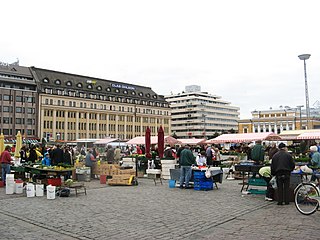
The Market Square is a city square in the city of Turku, in Finland. It is located in the city's VI District, and is generally considered the city's central square. It hosts a lively market on weekdays, and there are several cafés and restaurants on the square.

The Great Fire of Turku was a conflagration in the city of Turku in 1827. It is still the largest urban fire in the history of Finland and the Nordic countries. The city had faced several large fires before, including an especially devastating fire in 1681.

Vartiovuori Observatory is a former observatory in Turku, Finland. The observatory, designed by Carl Ludvig Engel, was originally built for the Royal Academy of Turku. The neoclassical building was completed in 1819. The observatory is situated atop the Vartiovuori hill, and it is clearly visible from different sides of the city centre.

Wäinö Aaltonen Museum of Art or WAM for short, is an art museum in central Turku, Finland dedicated especially to modern art. The museum is located on the east bank of the Aura River. The permanent exhibition is based on the art collection of the City of Turku, which includes a large collection of works by Finnish artist and sculptor Wäinö Aaltonen. Temporary exhibitions focus on Finnish and international modern art.

Daniel Juslenius was a Finnish writer and bishop. He was a professor of Hebrew, Greek and theology at the Royal Academy of Turku.
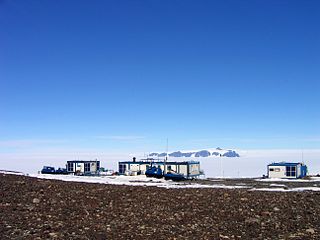
Aboa is a seasonal Finnish research station in Antarctica, located in Queen Maud Land, about 130 kilometres (81 mi) from the coast, on a nunatak called Basen in the Kraul Mountains.

Panimoravintola Koulu is a Finnish brewery restaurant in the city of Turku. Koulu is the largest brewery restaurant in Finland and it is situated in a former Neo-Renaissance style school building from 1889 by architects L. I. Lindqvist and Bruno Granholm. The school to first occupy the building was "Svenska Fruntimmerskolan i Åbo", which was later renamed as the "Svenska flickskolan i Åbo" in 1916, again in 1955 when it became "Åbo svenska flicklyseum", until finally in 1966 the name was changed to "Cygnaeus skola". On 4 February 1940, during the Winter War, the school was hit by a Soviet incendiary bomb, which set fire to the roof and destroyed the assembly hall. One of the high points in the history of Koulu was the visit of Commander-in-Chief, Baron Carl Gustaf Emil Mannerheim on 14 February 1941. The school was shut down in 1970. The restaurant was opened in 1998.

Lilja is a red granite sculpture by Wäinö Aaltonen, located in Turku, Finland. It is located in Runeberginpuisto near the Aurasilta. It depicts the lily, the flower of the Turku coat of arms. In 1927, the statue was the first public art commission in Turku.
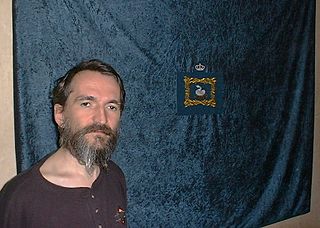
Timur Petrovich Novikov was a Russian visual artist, designer, art theorist, philosopher, and musician. He is considered one of the most influential proponents of Nonconformist Art before and after the dissolution of the Soviet Union in 1991.
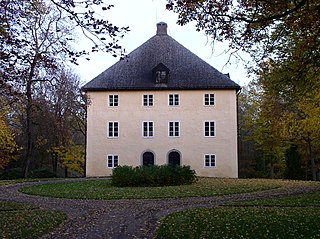
Kankainen Manor is a late medieval manor in Masku, Finland, located along a small river about one kilometre south of Masku town centre. Kankainen Manor is considered to be the oldest surviving residential building in Finland, as its oldest parts may be from the end of the 15th century. In 2009, the Finnish Heritage Agency defined it as one of Finland's nationally significant built cultural environments.
Ger C. Bout (1950-2017) was a Dutch architect and artist based in Rotterdam, the Netherlands. Following years of completing furniture designs, architectural structures and installations, Bout began initiating large scale projects in public spaces internationally. In recent years he has focused on and incorporated photography into his projects. His ideas are always process based; he applies multiple techniques and skills to realise his work using varieties of mediums and expressions from architecture to furniture design, installation, drawing, performance, sculpture and photography.
Hamburger Börs was an Art Nouveau hotel building in Turku, Finland, next to the Market Square built in 1909. It was designed by Frithiof Strandell as an expansion to a hotel located on Kauppiaskatu. The building had 30 hotel rooms. The inner yard hosted the Metropol film theatre, which had been built into a brick warehouse according to Strandell's plans. The theatre later functioned with the names Lyyra V and Rialto up to the 1960s.
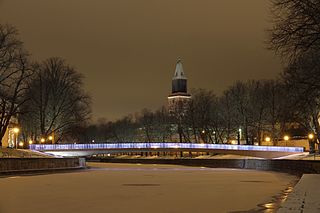
The Library Bridge is a pedestrian and cycling bridge in Turku designed by Pontek Oy. Located at the city centre, the bridge crosses the Aura River connecting the streets Kauppiaskatu and Rettiginrinne. The bridge was opened for traffic in 2013, and it was named as the result of a public naming contest. The Turku Main Library is located near the bridge.

















